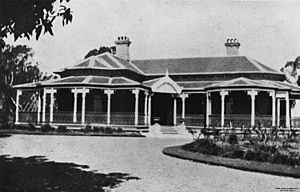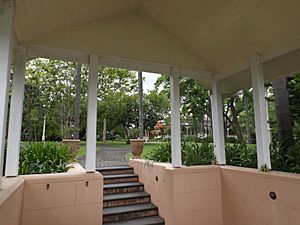Eulalia, Norman Park facts for kids
Eulalia is a special old house located at 75 McIllwraith Avenue in Norman Park, Queensland, Australia. It was built in 1889. This beautiful home is now listed on the Queensland Heritage Register. This means it is an important part of Queensland's history and is protected for future generations.
The Story of Eulalia House
Eulalia is a single-storey house made of brick. It was built in 1889. The land where the house stands was first bought in 1860 by August Dimper. He purchased a large area of about 88 acres. Later, in 1888, the land was divided into smaller pieces. Patrick Real then bought 22 acres of this land.
Building Eulalia: A Grand Design
In 1889, Patrick Real hired famous Brisbane architects, John Hall & Sons. They designed the house for him. Morley Whitehead of Ipswich was chosen to build it. The name "Eulalia" comes from a Greek word. It means "speaking well of everybody." It is possible that John Smith Murdoch, who worked for John Hall and Sons, helped design Eulalia.
Patrick Real: From Apprentice to Judge
Patrick Real had a remarkable life story. He was the son of Irish immigrants who were not wealthy. He left school at age twelve to become a carpenter's apprentice. Later, he worked at the North Ipswich Railway Workshops. Patrick then decided to study law. He became a lawyer at twenty-seven years old. By 1889, when Eulalia was built, his law practice was one of the biggest in Queensland. In 1890, Real was appointed to the Supreme Court of Queensland. He became a judge there. By 1903, he was the Senior Puisne Judge, a very important legal position. He retired in 1922 and passed away in 1928.
A Decade of Quiet and Restoration
After Patrick Real passed away, Eulalia was empty for ten years. During this time, it became damaged by vandals and the weather. Locals even started calling it the "haunted house." Most of the land around it had been sold by 1925. Only about 2.2 hectares remained around the house.
In 1938, Stanley and Sheilah Hancock bought Eulalia. They worked hard to restore the property. They even found many items in the gardens that vandals had thrown away. The Hancocks put these items back into the house.
The Hancock Family's Legacy
The Hancock family moved to Queensland in the late 1850s. They started a very successful timber milling business. Five generations of the Hancock family worked in this business until the late 1970s. Stanley Hancock was also the president of the National Trust of Queensland from 1974 to 1978. The National Trust helps protect important historical places. During his time, several National Trust properties were established. These included Bellevue Homestead, Claremont, and Brennan & Geraghtys Store.
While Eulalia was their family home, the Hancocks also used it for good causes. They held many fundraising events for different charities in Brisbane.
Early Street Historical Village
In 1965, the Hancocks expanded the "public" use of Eulalia. They created the Early Street Historical Village in the grounds of Eulalia. This village was one of the first of its kind in Queensland. It involved moving various old buildings to one central spot. This showed a new way of thinking about protecting historical places in Queensland.
The Early Street Historical Village closed in 1998. The buildings on the site were sold at auction. Most of them were moved to other areas to be used as homes.
Exploring Eulalia's Design
Eulalia is built on a high hill, offering wide views. It is a single-storey house with two wings at the back. The walls are made of brick with a smooth finish, and the roof is made of slate tiles.
Gardens and Surroundings
The entire area around Eulalia and the former Early Street Historical Village is filled with mature trees. These include gum trees, palm trees, bunya pines, jacarandas, and bougainvillea. These many plants make Eulalia a noticeable landmark in its suburban area. They also help show what the area looked like when Eulalia was first built, in a more rural setting. Other old structures on the property include a tank stand and a modified coach house.
Architectural Features of the House
The front of the house faces north. It has an entrance porch with a triangular top, called a pediment. This porch leads to a wide verandah. Two sections of the house stick out on either side of the porch. The verandah wraps around three sides of the house. It has a decorative cast iron fence, supported by tall, eight-sided timber posts. These posts have fancy tops and carved wooden brackets. The main wood used is beech.
Inside Eulalia: Elegant Details
The floor tiles are arranged in a pattern, starting from the slate steps at the porch. They continue through the entrance and into the wide hallway. The main door is made of panels. It has sidelights (narrow windows) with leaded glass. Above the door is a fanlight, a semi-circular window. This fanlight has a beautiful etched design of gum leaves, a swallow, and a dragonfly. Another similar doorway is at the other end of the hall.
On the right side of the hallway are separate drawing and dining rooms. The drawing room has a window bay. It features columns and pilasters (flat columns) with Doric designs. The dining room has cedar folding doors. These doors can be opened to create one large space with the hallway. On the left side of the hall are the master bedroom, dressing room, and sitting rooms.
All the wooden fittings inside the house are made of cedar. This includes the door frames (architraves) and the decorative panels above the doors (pedimented overdoors). These panels reach almost to the plaster cornice (a decorative molding) of the very high sixteen-foot ceilings. The drawing room has a fancy fireplace mantelpiece made of mahogany. Other fireplaces have oak mantelpieces. The long sash windows in the main rooms open onto the verandah. They even have small hinged "dog-doors" at floor level.
At the end of the main hall, the house splits into two wings. On the left, a verandah with a wooden railing leads to the bathroom and two bedrooms. On the right, another wing leads to the former study and service rooms. These include a kitchen, pantry, maid's room, and laundry. A large cellar is located underneath this wing.
Why Eulalia is a Heritage Site
Eulalia was added to the Queensland Heritage Register on 21 October 1992. It met several important requirements.
A Glimpse into Queensland's Past
Eulalia and its grounds were built in 1889. They show us how wealthy people lived in the outer parts of Brisbane in the late 1800s. This helps us understand the history of Queensland.
A Well-Preserved Example
The house is a great example of a high-quality Queensland home from the 1880s. It is made of brick and is still mostly original, both inside and out. It is also rare to find a 19th-century house that still has such large grounds. These grounds separate it from the modern suburban buildings around it. The gardens, with their old gum trees, palm trees, bunya pines, jacarandas, and bougainvillea, make the whole place special.
Beautiful Design and Craftsmanship
Eulalia has many rare and beautiful architectural features. These include the verandahs around the bay windows. The verandah posts and brackets are very detailed and finely made. The inside of the house also has high-quality finishes and fittings. These include cedar wood, internal pilasters and columns, and patterned floor tiles. All these features give Eulalia great aesthetic significance, meaning it is very beautiful.
A Local Landmark
Eulalia is located on a prominent hill. Its mature trees make the entire site a significant landmark in the area. It is easily recognized and stands out.
Connections to Important People
Eulalia is important because of its first owner, Patrick Real. He was a leading lawyer and judge in Brisbane in the early 1890s. His memory lives on in the nearby streets, like Judge, Patrick, and Real Streets. Katherine Street is named after a member of his family.
The house is also important because of its second owner, Stanley Hancock. He was the President of the National Trust of Queensland from 1974 to 1978. He played a big role in protecting Queensland's heritage.
Eulalia also has a strong connection to the Early Street Historical Village. This village was started in 1965 by the Hancocks. It was one of the first heritage properties in Queensland to be opened as a tourist and educational attraction.



